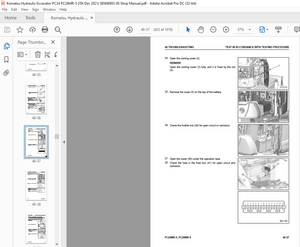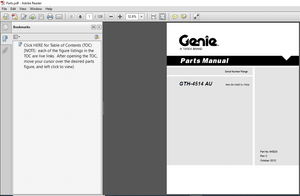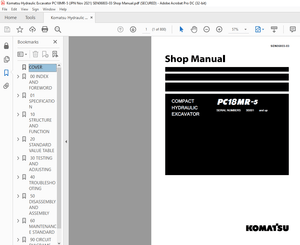$45
MTU Marine Application Technical Project Guide Manual PDF DOWNLOAD
MTU Marine Application Technical Project Guide Manual PDF DOWNLOAD
FILE DETAILS:
MTU Marine Application Technical Project Guide Manual PDF DOWNLOAD
Language :English
Pages :230
Downloadable : Yes
File Type : PDF
IMAGES PREVIEW OF THE MANUAL:



TABLE OF CONTENTS:
MTU Marine Application Technical Project Guide Manual PDF DOWNLOAD
I TABLE OF CONTENTS
Chapter Title Page
I INTRODUCTION I
II TABLE OF CONTENTS V
III LIST OF FIGURES XI
1 GENERAL 1-1
1.1 Designations 1-1
2 DEFINITION OF APPLICATION GROUPS 2-1
2.1 General Notes 2-1
2.2 Marine Main Propulsion and Auxiliary Propulsion Plants 2-2
2.3 On-Board Electric Power Generation/Auxiliary Power 2-3
3 SPECIFICATION OF POWER AND REFERENCE CONDITION 3-1
3.1 Definition of Terms 3-1
3.1.1 ISO Standard Fuel-Stop Power (ICFN) 3-1
3.1.2 ISO Standard Power Exceedable by 10 % (ICXN) 3-2
3.2 Reference Conditions 3-2
3.3 Intake Air (Quality) 3-3
3.4 Intake and Exhaust Pressure Loss 3-3
3.4.1 General 3-3
3.5 Inclination 3-5
3.6 Load Profile 3-6
3.7 Time Between Major Overhauls (TBO) 3-9
4 FLUIDS AND LUBRICANTS SPECIFICATION 4-1
4.1 General Notes 4-1
4.2 Approved Fuel for MTU Engines 4-1
4.2.1 Requirements 4-1
4.2.2 Low Sulphur Diesel Fuels 4-2
4.2.3 Diesel Fuels in Winter Operation 4-2
4.2.4 Fuel Properties for Calculation Routines 4-2
5 DIESEL ENGINE PERFORMANCE DIAGRAM 5-1
5.1 General Notes 5-1
5.2 Load Curves 5-7
Technical Project Guide
Marine Application
Page VI
Table of Contents
TPG-General.doc 04.2004 © MTU
Rev. 2.01
Chapter Title Page
6 PROPULSION, INTERACTION DIESEL ENGINE WITH APPLICATION 6-1
6.1 Propulsor 6-1
6.1.1 Abbreviations 6-1
6.1.2 Propulsive Devices (Overview) 6-3
6.1.2.1 General characteristics 6-3
6.1.2.2 Typical arrangements 6-5
6.1.2.3 Manoeuvring characteristics 6-7
6.1.3 Shaft Line and Gearbox Losses 6-9
6.2 Propeller 6-10
6.2.1 Propeller Geometry 6-10
6.2.2 Propeller Type Selection 6-12
6.2.2.1 FPP or CPP 6-12
6.2.2.2 Propeller size 6-13
6.2.2.3 Cavitation and thrust breakdown 6-13
6.2.2.4 Propeller for high speed vessels 6-13
6.2.3 Direction of Propeller Rotation 6-14
6.2.4 Selection of Propeller Blade Number 6-17
6.3 Propeller Curve 6-18
6.3.1 Basics 6-18
6.3.2 Theoretical Propeller Curve 6-23
6.3.3 Estimating the Required Diesel Engine Power 6-25
6.4 Propeller and Performance Diagram 6-26
6.4.1 Driving Mode 6-26
6.4.1.1 General applications 6-26
6.4.1.2 Bollard pull 6-28
6.4.2 Fixed Pitch Propeller (FPP) 6-30
6.4.3 Controllable Pitch Propeller (CPP) 6-32
6.5 Waterjet and Performance Diagram 6-38
6.5.1 Geometry and Design Point 6-38
6.5.2 Parallel Operation 6-43
6.5.3 Estimation of Size and Shaft Speed 6-44
6.6 Fuel Consumption 6-45
6.6.1 General Assumptions 6-45
6.6.2 Operating Profile 6-47
6.6.3 Fuel Consumption at Design Condition 6-52
6.6.4 Cruising Range 6-53
6.6.5 Endurance at Sea 6-54
6.6.6 Calculating Examples 6-55
6.6.6.1 Example Data (Series 2000) 6-55
6.6.6.2 Fuel consumption at design condition 6-57
6.6.6.3 Fuel tank volume for a given range 6-58
6.6.6.4 Theoretical cruising range 6-59
6.6.6.5 Annual fuel consumption for an operating profile 6-60
6.6.6.6 Correcting the lower heating value 6-61
6.7 Generator Drive 6-62
Technical Project Guide
Marine Application
Table of Contents Page VII
TPG-General.doc 04.2004 © MTU
Rev. 2.01
Chapter Title Page
7 APPLICATION AND INSTALLATION GUIDELINES 7-1
7.1 Diesel Engine/Gearbox Arrangements 7-1
7.1.1 General notes 7-1
7.1.2 Diesel Engine with Flange-Mounted Gearbox (F-Drive) 7-4
7.1.2.1 General notes 7-4
7.1.3 Diesel Engine with Free-Standing Gearbox, V-Drive Inclusive 7-5
7.1.3.1 General notes 7-5
7.1.4 Diesel Engine with Free-Standing Gearbox, Universal Shaft and V-drive 7-7
7.1.4.1 General notes 7-7
7.2 Foundation 7-8
7.3 Generator Set Arrangement 7-9
7.3.1 General Notes: 7-9
7.3.2 Diesel Engine with Free-Standing Generator 7-10
7.3.3 Diesel Engine with Flange-Mounted Generator 7-11
7.4 System Interfaces and System Integration 7-12
7.4.1 Flexible Connections 7-12
7.4.2 Combustion Air and Cooling/Ventilation Air Supply 7-15
7.4.2.1 General notes 7-15
7.4.2.2 Combustion air intake from engine room 7-16
7.4.2.3 Combustion air intake directly from outside (special application) 7-17
7.4.2.4 Cooling/ventilation air system 7-18
7.4.3 Exhaust System 7-20
7.4.3.1 Arrangements, support and connection for pipe and silencer 7-21
7.4.3.2 Water-cooled exhaust system 7-23
7.4.4 Cooling Water System 7-25
7.4.4.1 Cooling water system with on-engine mounted heat exchanger 7-26
7.4.4.2 Cooling water system with separately-mounted heat exchanger 7-27
7.4.4.3 Central cooling water system 7-28
7.4.4.4 Sea chest construction for ice ships 7-29
7.4.4.5 Ship heating 7-30
7.4.5 Fuel System 7-31
7.4.5.1 General notes 7-31
7.4.5.2 Design data 7-32
7.4.6 Lube Oil System 7-35
7.4.7 Starting System 7-38
7.4.7.1 Electric starter motor 7-38
7.4.7.2 Compressed-air starting, compressed-air starter motor 7-39
7.4.7.3 Compressed-air starting, air-in-cylinder 7-40
7.4.7.4 Starting aid measures 7-43
7.4.8 Electric Power Supply 7-44
Technical Project Guide
Marine Application
Page VIII
Table of Contents
TPG-General.doc 04.2004 © MTU
Rev. 2.01
Chapter Title Page
7.5 Emission 7-46
7.5.1 Exhaust Gas Emission, General Information 7-46
7.5.2 Acoustical Emission, General Information 7-47
7.5.2.1 Airborne noise level 7-48
7.5.2.2 Exhaust gas noise level 7-50
7.5.2.3 Structure-borne noise level 7-51
7.6 Mechanical Power Transmission 7-58
7.7 Auxiliary Power Take-Off (PTO), Power Take-In (PTI) 7-63
7.7.1 Diesel Engine Mounted PTO 7-63
7.7.2 Gearbox Mounted PTO/PTI 7-64
7.7.2.1 Gearbox shaft mounted auxiliary PTO 7-64
7.7.2.2 Gearbox top mounted PTO or PTI 7-65
7.7.2.3 Diesel engine with free end PTO 7-66
7.8 Torsional Vibration 7-67
8 CLASSIFICATION AND ACCEPTANCE TEST 8-1
8.1 Explanation of Important Classification and Acceptance Terms 8-1
8.1.1 Classification Societies 8-1
8.1.2 Ship Classification 8-1
8.1.3 List of Classification Societies 8-4
8.1.4 Characters of Classification and Notations 8-5
8.1.5 Type Approval/Prototype Test 8-9
8.1.6 Drawing Approval (Design Approval/Design Appraisal) 8-9
8.1.7 Classification Acceptance 8-9
8.1.8 Test run control 8-9
8.1.9 Factory Acceptance Test (FAT) 8-10
8.2 Acceptance Test According to a Classification Society 8-10
8.2.1 Main Diesel Engines for Direct Propeller Drive: 8-10
8.2.2 Main Diesel Engines for Indirect Propeller Drive 8-10
8.2.3 Diesel Engines for Auxiliary and Electric Generator Drives 8-10
8.3 Example Documents 8-11
9 DIESEL ENGINE CONTROL SYSTEM 9-1
9.1 General 9-1
10 SHIP AUTOMATION SYSTEM 10-1
10.1 Pre Configured Automation Systems 10-1
10.1.1 Standard Monitoring and Control for Diesel Engine Series 2000/4000 10-1
10.1.2 BlueLine Monitoring and Control for Diesel Engine Series 2000/4000 10-3
10.1.3 Configuration documents for Monitoring and Control systems 10-5
10.2 Project Specific Ship Automation Systems 10-5
Technical Project Guide
Marine Application
Table of Contents Page IX
TPG-General.doc 04.2004 © MTU
Rev. 2.01
Chapter Title Page
11 MAINTENANCE CONCEPT / MAINTENANCE SCHEDULE 11-1
11.1 Reason for Information 11-1
11.2 Advantages of the Maintenance Concept: 11-1
11.3 Maintenance Schedule: 11-1
11.3.1 Cover Sheet 11-1
11.3.2 Maintenance Schedule Matrix 11-2
11.3.3 Task List 11-6
12 ASSEMBLING INSTRUCTIONS (TRANSPORT, STORAGE, STARTING) 12-1
12.1 Transportation 12-1
12.2 Storage and Starting 12-1
13 INSTALLATION DESCRIPTION 13-1
APPENDIX
A ILLUSTRATION REFERENCES 1
B CONVERSION TABLE 3
C GLOSSARY 9



